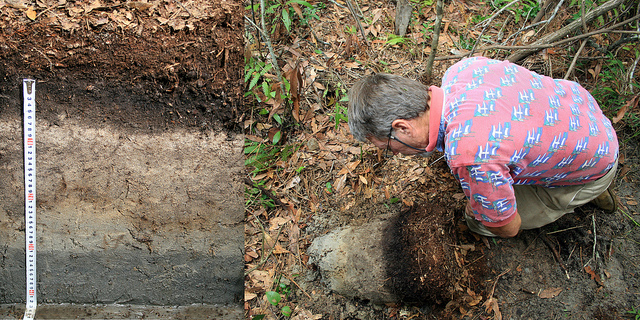
This is a guest post from Daniel Kane, a soil scientist and agroecologist who researches soil carbon cycles, regenerative agriculture, and sustainable food systems. Last year, the National Sustainable Agriculture Coalition (NSAC) and Breakthrough Strategies and Solutions, LLC, jointly published a paper (“Carbon Sequestration Potential on Agricultural Lands: A Review of Current Science and Available Practices”) that Daniel authored, exploring how soil carbon is sequestered, the state of soil carbon research, and the debate on its potential. In this post Daniel provides an overview of recent findings on the potential for agricultural management practices to mitigate climate change. Our follow up piece tomorrow will highlight policy opportunities related to climate change and agriculture.
Earlier this month, the journal Nature published alarming new data about the potential for much higher sea level rise this century due to melting in Antarctica than previously predicted, and NASA reported that 2015 was the hottest year on record. As the impacts of climate change are increasingly apparent, the need to not only reduce emissions but to also draw carbon out of the atmosphere has become more urgent. One potential solution is literally underfoot.
Last week, the journal Nature published a review that was all about the role of soils in addressing climate change, and earlier this year NSAC and Breakthrough Strategies and Solutions published a similar paper detailing different agricultural practices with the potential to build carbon in the soil. Both papers highlight a growing body of evidence that with proper management, soils could play an important role in battling climate change.
What’s Agriculture Got to Do with Climate Change?
Globally, land use accounts for nearly a quarter of human greenhouse gas emissions. Poor management of agricultural lands and the conversion of native ecosystems to agriculture can lead to release of all three primary greenhouse gases: CO2 (carbon dioxide), CH4 (methane), and N2O (nitrous oxide) via soils. The good news in the Nature review and the NSAC report is that improving agricultural management can substantially reduce these emissions and in some cases sequester carbon from the atmosphere in the soil.
Nitrous Oxide
To start, N2O emissions can quickly be reduced in agricultural systems by improving nitrogen fertilizer use efficiency. According to the review in Nature, “fertilized crops typically take up less than 50% of the N applied; the remainder is available for loss.” Fertilizer that isn’t used by crop plants either remains in the soil or finds it way into nearby water sources. In both cases, bacteria can utilize that fertilizer to aid metabolic processes in their cells, converting it into N2O. As the authors argue, improving fertilizer use efficiency and reducing application rates could reduce annual N2O emissions in a number of cropping systems.
Methane
Groups of soil bacteria called methanogens can also emit CH4 when soils are saturated with water, which reduces the availability of oxygen and forces these bacteria to utilize carbon molecules to complete chemical reactions. CH4 emissions are particularly high in rice systems, where fields are often flooded. The authors of the Nature review note that changing production models so that fields are periodically drained could reduce CH4 emissions by as much as 25%. These changes could be especially important as global rice production is expected to increase over the next 10 years.
Soils as a Carbon Storehouse
But management interventions to reduce N2O and CH4 emissions are just the start. Soils can also act as a storehouse for carbon. As plants grow, they take up CO2 from the atmosphere via photosynthesis, leaving it behind in the soil when they die. There, microbes feed on the plant material converting some to CO2, while some eventually forms the rich brown topsoil in which we grow crops.
Farmers can manage this cycle to increase soil carbon (soil C) by increasing the quantity and quality of plant biomass they produce while also reducing how much CO2 is lost from soil C. Years of farmer experience and agricultural experience have turned up a few particularly promising practices that we highlight in our review. Winter cover crops prevent loss of soil C by erosion and provide additional plant material to soils. No-till and conservation tillage protect soil aggregates that protect carbon from being disrupted. Carbon rich inputs, such as compost and biochar, can improve soil fertility and improve soil aggregate formation, helping to better protect soil C.
Estimates of the total global mitigation potential of reducing soil GHG emissions and increasing soil C sequestration vary. The authors of the review in Nature place it as high as 8 trillion kilograms CO2(eq) per year, or the equivalent of removing nearly 169 million cars from the road per year. But some estimates are much lower, and gaps in our knowledge of soil GHG cycles and little data on adoption rates of the practices described above make it difficult to produce estimates.
Still, even without a full accounting of the impact of soil management, both these reviews highlight soil’s powerful potential and the need to start including it our climate toolbox.
Implementation Barriers Remain
But farmers and land managers who want to implement the necessary practices still face substantial financial, social, and technological barriers. Both papers argue that continuing research will help to fill important knowledge gaps, while developing more accessible and less expensive tools to estimate agricultural GHG footprints will allow farmers and scientists to measure impacts in real-time. More research and on-farm verification could make soil GHG mitigation practices viable in carbon-offset markets while also providing data for a proof-of-concept that could garner greater policy support.
Stay tuned for a follow-up blog post detailing potential policy tools that could help create climate-smart soils.


We made a four-minute film “Soil Solutions to Climate Problems” to make these ideas accessible to more people. If you haven’t seen it you can find it on YouTube. Thanks for a great post.